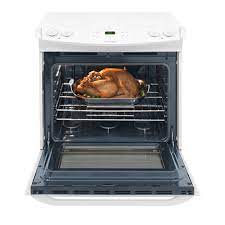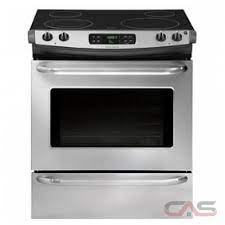![]()
Frigidaire CFES3025 Built-In Range
About Frigidaire
Frigidaire is a brand of home appliances that is owned by the Electrolux Group. It was founded in the United States in 1918 and is now a global brand, offering a wide range of products including refrigerators, freezers, air conditioners, dishwashers, ranges, cooktops, wall ovens, washers and dryers, and more.
Frigidaire is known for its commitment to quality, innovation, and design, and offers products in a range of styles and price points to meet the needs of different consumers. If you’re in the market for a new appliance, Frigidaire is a reputable brand that offers a wide selection of high-quality products that can help make your home more comfortable and convenient.
WELCOME & CONGRATULATIONS
Congratulations on your purchase of a new appliance! At Electrolux Home Products, we are very proud of our product and are completely committed to providing you with the best service possible. Your satisfaction is our number one priority.
We know you’ll enjoy your new appliance and Thank You for choosing our product. We hope you consider us for future purchases.
PLEASE CAREFULLY READ AND SAVE THESE INSTRUCTIONS
This Use & Care Manual contains general operating instructions for your appliance and feature information for several models. Your product may not have all the described features. The graphics shown are representative. The graphics on your appliance may not look exactly like those shown. These instructions are not meant to cover every possible condition and situation that may occur. Common sense and caution must be practiced when installing, operating, and maintaining any appliance.
IMPORTANT SAFETY INSTRUCTIONS
Read all instructions before using this appliance. Save these instructions for future reference.
DEFINITIONS
This is the safety alert symbol. It is used to alert you to potential personal injury hazards. Obey all safety messages that follow this symbol to avoid possible injury or death.
- Remove all tape and packaging wrap before using the appliance. Destroy the carton and plastic bags after unpacking the appliance. Never allow children to play with packaging material. Do not remove the wiring label and other literature attached to the appliance. Do not remove the model/serial number plate.
- Proper Installation. Be sure your appliance is properly installed and grounded by a qualified technician in accordance in the United States with the National Electrical Code ANSI/NFPA No. 70-latest edition, and local code requirements, and in Canada with CSA C22.1 PART 1-latest edition and local code requirements. Install only per installation instructions provided in the literature package for this range.
Ask your dealer to recommend a qualified technician and an authorized repair service. Know how to disconnect the electrical power to the appliance at the circuit breaker or fuse box in case of an emergency.
- User Servicing. Do not repair or replace any part of the appliance unless specifically recommended in the manuals. All other servicing should be done only by a qualified technician to reduce the risk of personal injury and damage to the appliance.
- Never modify or alter the construction of an appliance by removing leveling legs, panels, wire covers, anti-tip brackets/screws, or any other part of the product.
WARNING Stepping, leaning, sitting, or pulling down on the door or the drawer of this appliance can result in serious injuries and also cause damage to the appliance. Do not allow children to climb or play around the appliance. The weight of a child on an open door may cause the appliance to tip, resulting in serious burns or another injury. An open drawer when hot may cause burns.
WARNING Do not use the oven or warm & serve drawer (if equipped) for storage.
- Storage in or on Appliance. Flammable materials should not be stored in an oven, near surface burners, or in the warm & serve drawer (if equipped). This includes paper, plastic, and cloth items, such as cookbooks, plastic ware, and towels, as well as flammable liquids. Do not store explosives, such as aerosol cans, on or near the appliance. Flammable materials may explode and result in fire or property damage.
CAUTION Do not store items of interest to children in the cabinets above the appliance. Children climbing on the cooktop to reach items could be seriously injured
- Do not leave children alone. Children should not be left alone or unattended in the area where an appliance is in use. They should never be allowed to sit or stand on any part of the appliance.
- DO NOT TOUCH SURFACE UNITS, AREAS NEAR
THESE UNITS, OVEN HEATING ELEMENTS, OR INTERIOR SURFACES OF THE OVEN. Both surface units and oven heating elements may be hot even though they are dark in color. Areas near surface units may become hot enough to cause burns. During and after use, do not touch, or let clothing or other flammable materials touch these areas until they have had sufficient time to cool. Among these areas are the cooktop, surfaces facing the cooktop, the oven vent openings and surfaces near these openings, the oven door, and the window.
- Wear Proper Apparel. Loose-fitting or hanging garments should never be worn while using the appliance. Do not let clothing or other flammable materials contact hot surfaces.
- Do Not Use Water or Flour on Grease Fires. Smother the fire with a pan lid, or use baking soda, a dry chemical, or a foam-type extinguisher.
- When heating fat or grease, watch it closely. Fat or grease may catch fire if allowed to become too hot.
- Use Only Dry Pot holders. Moist or damp pot holders on hot surfaces may result in burns from steam. Do not let the pot holders touch hot surface units. Do not use a towel or other bulky cloth instead of a pot holder.
- Do Not Heat Unopened Food Containers. The buildup of pressure may cause the container to burst and result in injury.
- Remove the oven door from any unused appliance if it is to be stored or discarded.
IMPORTANT Do not attempt to operate the appliance during a power failure. If the power fails, always turn off the unit. If the unit is not turned off and the power resumes, the appliance will not operate and an error message will be displayed. Once the power resumes, reset the clock and the oven function.
CAUTION
Electronic controllers can be damaged by cold temperatures. When you use your appliance for the first time, or if it has not been used for a long period, make sure that it has been exposed to a temperature above 0°C/32°F for at least 3 hours before connecting it to the power supply.
IMPORTANT INSTRUCTIONS FOR USING YOUR COOKTOP
- Know which knob controls each surface heating unit. Place a pan of food on the element before turning it on, and turn the element off before removing the pan.
- Use Proper Pan Size—This appliance is equipped with one or more surface burners of different sizes. Select utensils having fl at bottoms large enough to cover the surface unit. The use of undersized utensils will expose a portion of the surface heating unit to direct contact and may result in the ignition of clothing. Proper relationship of utensils to the surface will also improve efficiency.
- Utensil Handles Should Be Turned Inward and Should Not Extend Over Adjacent Surface
- Units—To reduce the risk of burns, ignition of flammable materials, and spillage due to unintentional contact with the utensil.
- Do not use the Searing Grill on the cooktop—The Searing grill is not designed for use on the cooktop. Doing so may result in a fire.
- Never Leave Surface Units Unattended—Boilovers cause smoking and greasy spillovers that may ignite, or a pan that has boiled dry may melt.
- Protective Liners—Do not use aluminum foil to line the oven bottom or any other part of the appliance. Only use aluminum as recommended for baking if used as a cover placed on the food. Any other use of protective liners or aluminum foil may result in a risk of electric shock fire or a short circuit.
- Glazed Cooking Utensils—Only certain types of glass, glass/ceramic, ceramic, earthenware, or other glazed utensils are suitable for cooktop service without breaking due to sudden temperature changes. Check the manufacturer’s recommendations for cooktop use.
- Do Not Use Decorative Surface Burner Covers. If an element is accidentally turned on, the decorative cover will become hot and possibly melt. Burns will occur if the hot covers are touched. Damage may also be done to the cooktop.
FOR COOKTOPS WITH COIL ELEMENTS ONLY
- Do Not Immerse or Soak Removable Surface Heating Elements. Surface heating elements should never be immersed in water. Heating elements clean themselves during normal operation.
- Make Sure Drip Pans or Drip Bowls Are in Place. The absence of these pans or bowls during cooking may subject wiring or components underneath to damage.
FOR GLASS COOKTOP ONLY
- Do Not Clean or Operate a Broken Cooktop— If the cooktop breaks, cleaning solutions and spillovers may penetrate the broken cooktop and create a risk of electric shock. Contact a qualified technician immediately.
- Clean Cooktop Glass with Caution— If a wet sponge or cloth is used to wipe spills on a hot cooking area, be careful to avoid a steam burn. Some cleaners can produce harmful fumes if applied to a hot surface.
- Avoid Scratching the Cooktop Glass with Sharp Objects.
IMPORTANT SAFETY INSTRUCTIONS FOR USING YOUR OVEN
- Use Care When Opening Oven Door—Stand to the side of the appliance when opening the door/drawer of a hot appliance. Let hot air or steam escape before you remove or replace food in the oven/drawer.
- Keep Oven Vent Ducts Unobstructed. The oven is vented at the front above the oven door. Touching the surfaces in this area when the oven is operating may cause severe burns. Also, do not place plastic or heat-sensitive items on or near the oven vent. These items could melt or ignite.
WARNING NEVER cover any slots, holes, or passages in the oven bottom or cover an entire rack with materials such as aluminum foil. Doing so blocks air flow through the oven and may cause carbon monoxide poisoning. Aluminum foil linings may trap heat, causing a fire hazard.
- Placement of Oven Racks. Always place oven racks in the desired location while the appliance is cool. Remove all utensils from the rack before removing the rack. If the rack must be moved while the oven is hot, use extreme caution. Use pot holders and grasp the rack with both hands to reposition. Do not let pot holders contact the hot oven element or interior of the oven.
- Do not use a broiler pan without its insert. The broiler pan and grid allow dripping fat to drain and be kept away from the high heat of the broiler.
- Do not cover the broiler grid or oven bottom with aluminum foil. Exposed fat and grease could ignite.
- Do not touch a hot oven light bulb with a damp cloth. Doing so could cause the bulb to break. Disconnect the appliance or shut off the power to the appliance before removing and replacing the bulb.
IMPORTANT SAFETY INSTRUCTIONS FOR CLEANING YOUR OVEN
- Clean the appliance regularly to keep all parts free of grease that could catch fire. Exhaust fan ventilation hoods and grease filters should be kept clean. Do not allow grease to accumulate. Greasy deposits in the fan could catch fire. Refer to the hood manufacturer’s instructions for cleaning.
- Cleaners/Aerosols—Always follow the manufacturer’s recommended directions for use. Be aware that excess residue from cleaners and aerosols may ignite causing damage and/or injury.
FOR SELF-CLEANING OVEN
- Clean in the self-cleaning cycle only the parts of the appliance listed in this Owner’s Guide. Before using the self-cleaning cycle of the appliance, remove all utensils stored in the appliance.
- Do not clean the oven door gasket. The door gasket is essential for a good seal. Care should be taken not to rub, damage, or move the gasket.
- Do not use oven cleaners. No oven cleaner or oven liner protective coating of any kind should be used in or around any part of the appliance.
- Remove oven racks. The oven rack’s color will change if left in the oven during a self-cleaning cycle.
FEATURES AT A GLANCE – MODEL A
Your built-in range Features: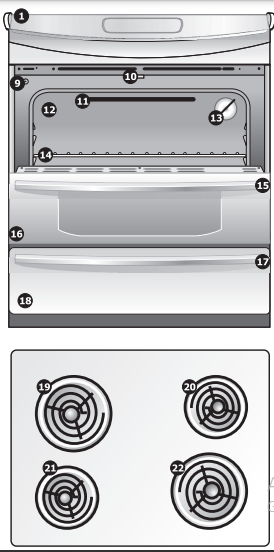
- Control Panel.
- Left front element control.
- Left rear element control.
- Right rear element control.
- Right front element control.
- Oven light switch.
- Element on indicator lights.
- Electronic oven control with a kitchen timer.
- Automatic oven door light switch.
- Self-clean door latch.
- Broil element.
- Self-cleaning oven interior.
- Oven interior light with removable cover.
- Adjustable interior oven rack(s).
- Large 1-piece oven door handle.
- Full-width oven door with window.
- Large 1-piece drawer handle (Stainless steel models only).
- Storage drawer.
- 8” Coil element.
- 6” Coil element.
- 6” Coil element.
- 8” Coil element.
FEATURES AT A GLANCE – MODEL B
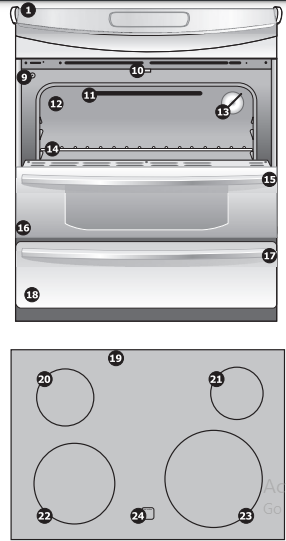
Your built-in range Features:
- Control Panel.
- Left front element control.
- Left rear element control.
- Right rear element control.
- Right front element control.
- Oven light switch.
- Element on indicator lights.
- Electronic oven control with a kitchen timer.
- Automatic oven door light switch.
- Self-clean door latch.
- Broil element.
- Self-cleaning oven interior.
- Oven interior light with removable cover.
- Adjustable interior oven rack(s).
- Large 1-piece oven door handle.
- Full-width oven door with window.
- Large 1-piece drawer handle (Stainless steel models only).
- Storage drawer.
- Ceramic Glass Cooktop.
- 7” Radiant element.
- 6” Radiant element.
- 9” Radiant element.
- 12” Radiant element.
- Hot surface indicator light
SURFACE COOKING
Selecting Surface Cooking Cookware
Cookware should have fl at bottoms that make good contact with the entire surface heating element. Check for flatness by rotating a ruler across the bottom of the cookware (See Figure 1).
Cookware Material types
The cookware material determines how evenly and quickly heat is transferred from the surface element to the pan bottom. The most popular materials available are:
- ALUMINUM – Excellent heat conductor. Some types of food will cause it to darken (Anodized aluminum cookware resists staining & pitting). If aluminum pans slide across the ceramic glass cooktop, they may leave metal marks that will resemble scratches. Remove these marks immediately.
- COPPER – Excellent heat conductor but discolors easily. May leave metal marks on ceramic glass (see Aluminum above).
- STAINLESS STEEL – Slow heat conductor with uneven cooking results. Is durable, easy to clean, and resists staining. CAST
- IRON – A poor heat conductor however will retain heat very well. Cooks evenly once cooking temperature is reached. Not recommended for use on ceramic cooktops.
- PORCELAIN-ENAMEL on METAL – Heating characteristics will vary depending on the base material. The porcelain-enamel coating must be smooth to avoid scratching ceramic cooktops.
- GLASS – Slow heat conductor. Not recommended for ceramic cooktop surfaces because it may scratch the glass.
Specialty Pans & Trivets
Works with fl at bottoms suitable for use on your cooktop are available in most cookshops or hardware stores. Round-bottomed works (with a support ring that does not extend beyond the heating element) may also be used. The metal ring was designed to support the work safely when it is filled with large amounts of liquids (soup making) or fat (frying).
Canning Tips & Information
- Use tested recipes and follow instructions carefully. Check with your local Cooperative Agricultural Extension Service or a manufacturer of glass jars for the latest canning information.
- Use flat-bottomed canners only. Heat is spread more evenly when the bottom surface is flat.
- Center canner on the burner grate.
- Start with hot water and a high heat setting to reduce the time it takes to bring the water to a boil; then reduce the heat setting as low as possible to maintain a constant boil.
- It is best to use small amounts and light loads.
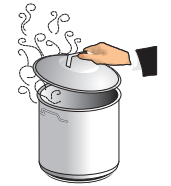
CAUTION
Canning can generate large amounts of steam. Use extreme caution to prevent burns. Always raise the lid to vent steam away from you.
Prevent damage to cooktop and burner grates:
- Do not use water baths or pressure canners that extend more than one inch beyond the edge of the burner grate.
- Do not leave water baths or pressure canners on high heat for an extended amount of time.
- Alternate surface units between each batch to allow the units and surrounding surfaces to cool down. Try to avoid canning on the same burner unit all day.
Safe canning requires that harmful micro-organisms are destroyed and the jars are sealed completely. When canning in a water bath canner, a gentle but steady boil must be maintained continuously for the required time.
BEFORE SETTING SURFACE CONTROLS
Ceramic Glass Cooktop (some models)
The ceramic cooktop has radiant surface elements located below the surface of the glass. The design of the ceramic cooktop outlines the area of the surface element underneath. Make sure the diameter of the pan matches the diameter of the element outline on the cooktop. Heat is transferred up through the surface of the cooktop to the cookware. Only fl at-bottom cookware should be used. The type and size of cookware, the number of surface elements in use, and their settings are all factors that will affect the amount of heat that will spread to areas beyond the surface elements. The areas surrounding the elements may become hot enough to cause burns.
About the Radiant Surface Elements
The element temperature rises gradually and evenly. As the temperature rises, the element will glow red. To maintain the selected setting, the element will cycle ON and OFF. The heating element retains enough heat to provide uniform and consistent heat during the OFF cycle. For efficient cooking, turn OFF the element several minutes before cooking is complete. This will allow residual heat to complete the cooking process.
Types of the heating elements used
Your cooktop is equipped with radiant surface radiant elements with different wattage ratings. The ability to heat food quicker and in larger volumes increases as the element wattage increases.
Element ON (all models)
Your appliance is equipped with two different types of radiant surface control indicator lights that will glow in the backyard- the Element On indicator light and the hot surface indicator light. The element ON indicator lights are located on the control panel (Figure 1) between the two radiant element control knobs and will glow when a surface element is turned ON.
Operating the Surface Elements
To Operate the Surface Elements
- Place correctly sized cookware on the surface element.
- Push in and turn the surface control knob in either direction to the desired setting (Figure 1).
- Turn the knob to adjust the setting if desired. Start most cooking operations on a higher setting and then turn to a lower setting to finish cooking. Each surface element provides a constant amount of heat at each setting. Ceramic Glass Cooktop Only: A glowing red surface heating area extending beyond the bottom edge of the cookware indicates the cookware is too small for the surface heating area.
- When cooking has completed, turn the surface control knob to OFF before removing the cookware.
Oven Vent Location
The oven is vented Through the front panel and visible when the oven door is open. When the oven is on, warm air is released through the vent. This venting is necessary for proper air circulation in the oven and good baking results. DO NOT block the vent. Doing so may cause cooking failures, fire re, or damage to the appliance.
Air circulation in the oven
If using 1 rack, place in center of oven. If using multiple racks, stagger cookware as shown. For best air circulation and baking results allow 2-4″ (5-10cm) around the cookware for proper air circulation and be sure pans and cookware do not touch each other, the oven door, sides, or back of the oven cavity. The hot air must circulate the pans and cookware in the oven for even heat to reach the food.
Recommended rack positions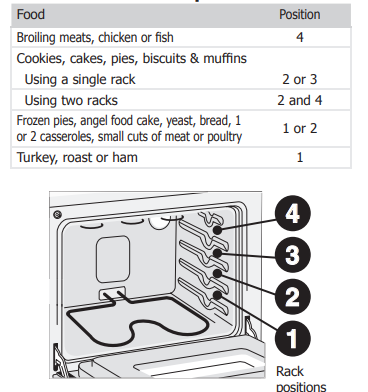
Control pad features
READ THE INSTRUCTIONS CAREFULLY BEFORE USING THE OVEN. For satisfactory use of your oven, become familiar with the various features and functions of the oven as described below. Detailed instructions for each feature and function follow later in this Use & Care Guide.
- Clock pad—Use to set the time of day.
- Bake time pad—Use to enter the length of the baking time.
- Timer on-off pad—Use to set or cancel the Timer. The Timer does not start or stop cooking.
- Start time pad—Used to set the desired start time for baking. Can be used with BAKE TIME to program a delayed bake cycle.
- Oven, preheat & door-locked lights— The “oven” light will glow each time the oven unit turns on to maintain the set oven temperature. The “Preheat” light will glow when the oven is first set to operate, or if the desired temperature is reset higher than the actual oven temperature. The “Door Locked” light will flash until the door locks when the self-clean cycle is in use. It glows constantly after the door locks.
- Up arrow pad—Used along with the function pads to select oven temperature, time of day, and minute timer.
- Bake pad—Use to select the bake cooking feature.
- Feature indicator lights—These light to show which feature is in use.
- Broil pad—Use to select the broil cooking feature.
- Down arrow pad—Used along with the function pads to select oven temperature, time of day, and minute timer.
- Clear off the pad—Use to cancel any oven feature previously entered except the time of day and minute timer.
- Clean Pad—Used to select the self-cleaning cycle.
Setting Broil
This mode is best for meats, fish, and poultry up to 1” thick. Broiling is a method of cooking tender cuts of meat by direct heat under the broil element of the oven. The high heat cooks quickly and gives a rich, brown outer appearance. The BROIL pad controls the Broil feature. An optional Searing Grill, Broiler Pan, and Insert are available via the enclosed accessories brochure (Figures 1 & 2). The optional broil pan and broil pan insert used together allow dripping grease to drain and be kept away from the high heat of the oven broiler. Broiling Tips:
- For optimum browning, preheat the broil element for 5 minutes.
- Broil one side until the food is browned; turn and cook on the second side. Season and serve.
- Always pull the rack out to the “stop” position before turning or removing food.
- Always use the broiler pan and its cover when broiling. It allows the dripping grease to be kept away from the high heat of the broil element (see Figure 1).
- For best broiling results, broil with the oven door in the broil stop position (see Figure 3).
- If using a Searing Grill (available by mail order), preheat the grill for 5 to 10 minutes before placing your meat.
- DO NOT use the broil pan without the insert. DO NOT cover the broil pan insert with foil. The exposed grease could catch fire.
To set the Broil:
- Arrange the oven rack while the oven is still cool.
- Push the BROIL
- Push and hold the UP or DOWN ARROW pad until the desired broil setting level appears in the display. Push UP the ARROW pad for the HI broil or the DOWN ARROW pad for the LO broil. Most foods can be boiled at the HI broil setting. Select the LO broil setting to avoid excess browning or drying of foods that should be cooked to the well-done stage.
- Place the grid on the broiler pan, then place the food on the grid. DO NOT use the broiler pan without the grid or cover the grid with aluminum foil. The exposed fat could ignite.
- Place the pan on the oven rack. Open the oven door to the broil stop position when broiling (Figure 3).
- Broil on one side until food is browned; turn and cook on the second side. Note: Always pull the rack out to stop position before turning or removing food.
- When broiling is finished, push the CLEAR OFF
To Set the Bake time Feature
The BAKE TIME and START TIME controls operate the Timed Bake Feature. The automatic timer will turn the oven on and off at the times you select in advance. The oven can be programmed to start immediately and shut off automatically or to begin baking at a later time with an automatic shut-off.
To Program the Oven to Begin Baking Immediately and To Shut Off Automatically:
- Be sure that the clock shows the correct time of day.
- Place the food in the oven and push the BAKE
- Within 5 seconds, push the UP or DOWN ARROW The display will show “350°F (177°C)”. By holding the UP or DOWN ARROW pad, the temperature can then be adjusted in 5°F (1°C) increments.
- Push the BAKE TIME “0:00” will flash in the display.
- Push the UP or DOWN ARROW pad until the desired amount of baking time appears in the display.
To Program Oven for a Delayed Start Time and to Shut-Off Automatically:
- Be sure that the clock shows the correct time of day.
- Place the food in the oven and push the BAKE
- Within 5 seconds, push the UP or DOWN ARROW The display will show “350°F (177°C).” By holding the UP or DOWN ARROW pad, the temperature can then be adjusted in 5°F (1°C) increments.
- Push the BAKE TIME “0:00” will flash in the display.
- Push the UP or DOWN ARROW pad until the desired amount of baking time appears.
- Push the START TIME
- Push the UP or DOWN ARROW pad until the desired start time appears in the display.
- Once the controls are set, the control calculates when baking will stop.
Once the Controls are Set:
- The oven will come on and begin heating to the selected baking temperature.
- The oven temperature (or time of day) will show in the display.
When the Set Bake Time Runs Out:
- “END” will appear in the display window and the oven will shut off automatically.
- The control will beep 3 times every 60 seconds until the CLEAR OFF pad is pushed.
To Change the Oven Temperature or Bake Time after Baking has started:
- Push the function pad you want to change.
- Push the UP or DOWN ARROW pad to adjust the setting.
Self-cleaning
A self-cleaning oven cleans itself with high temperatures (well above normal cooking temperatures) which eliminates soils or reduces them to a fine powdered ash you can wipe away with a damp cloth.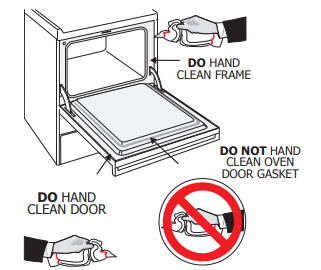
What to Expect During Cleaning
While the oven is in operation, the oven heats to temperatures much higher than those used in normal cooking. Sounds of metal expansion and contraction are normal. Odor is also normal as the food soil is being removed. Smoke may appear through the oven vent. If heavy spillovers are not wiped up before cleaning, they may flame and cause more smoke and odor than usual. This is normal and safe and should not cause alarm. If available, use an exhaust fan during the self-cleaning cycle.
To Set the Controls for a Self-Clean Cycle:
- Be sure the clock shows the correct time of day.
- Push the CLEAN pad. “- – -” appears in the display.
- Push the UP ARROW pad until “3:00” appears in the display for a 3-hour cycle, or push the DOWN ARROW pad until “2:00” appears in the display for a 2-hour cycle.
- As soon as the UP or DOWN ARROW pad is released, “CLn” appears on the display.
- As soon as the controls are set, the motor-driven lock will begin to close automatically and the “Door Locked” indicator light will flash. DO NOT open the door while the light is flashing (it takes about 15 seconds for the lock to close).
- The “Door Locked” light will glow until the cleaning cycle is completed or canceled, and the oven temperature has cooled.
When the Self-Clean Cycle is Completed:
- The time of day will appear in the display window and the “Door Locked” light will continue to glow.
- Once the oven has cooled down for about 1 hour and the “Door Locked” light has gone out, the oven door can be opened.
Stopping or Interrupting a Self-Cleaning Cycle If it becomes necessary to stop or interrupt a self-cleaning cycle due to excessive smoke or fi re:
- Push the CLEAR OFF pad.
- Once the oven has cooled down for about 1 hour and the “Door Locked” light has gone out, the oven door can be opened.
- Correct the condition that caused the smoking.
- Restart the self-clean cycle once all conditions have been corrected.
Failure Modes
All failure modes give a visual and audible alarm. When the display shows F10 (temperature runaway), F30 (oven sensor circuit fault), or F90 (motor door lock fault), the electronic oven control has detected a fault condition. Note that code and push the CLEAR OFF pad to clean the display and stop the beeping. Reprogram the oven. If fault recurs, push the CLEAR OFF pad, disconnect the appliance to prevent damage, and contact an authorized servicer.
CARE & CLEANING (Cleaning Chart)
Cleaning various parts of your appliance
Before cleaning any part of the appliance, be sure all controls are turned off and the appliance is COOL. REMOVE SPILLOVERS AND HEAVY SOILING AS SOON AS POSSIBLE. REGULAR CLEANING WILL REDUCE THE NUMBER OF MAJOR CLEANING LATER.
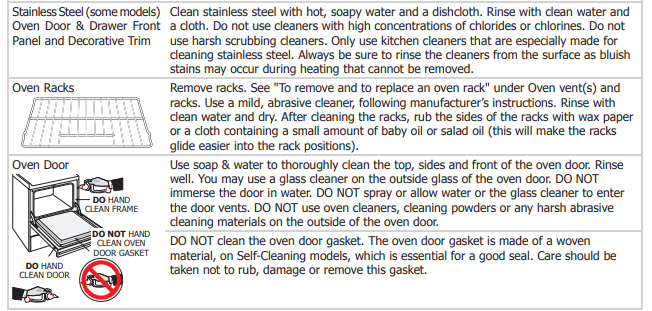
Coil Elements Cooktop Cleaning &Maintenance (Model A only)
- Before cleaning the coil elements make sure they are cold and that control knobs are set to OFF.
To Remove and Replace Surface Elements and Drip Bowls (Model A only)
To Remove
- Lift the edge of the surface element across from the terminal end just enough to clear the edge of the drip bowl.
- Gently slide the surface element out of the terminal plug.
- Lift the drip bowl up and out.
To Replace
- Line up the opening of the drip bowl with the terminal plug.
- Hold the surface element as level as possible and slide the terminal end through the opening and into the terminal plug.
- Be sure the surface element is level to reduce the hazard of pans sliding off the element.
To Raise the Top for Cleaning (Model A only)
- Grasp the sides and lift from the front. Some models may have a lift-up rod to support the top in its raised position. Lift the top only high enough to allow the support rod to fit into place, then gently lower the cooktop onto the raised rod.
- Clean underneath using a clean cloth and hot, soapy water.
- Gently lower the cooktop into the frame. If your model has a support rod, lower the support rod, then gently lower the cooktop into the frame.
Daily Cleaning For normal soil:
- Allow the cooktop surface to cool.
- Wipe off spills and spatters using a clean paper towel or a clean cloth with warm, soapy water.
- If needed, use a soapy steel wool pad or other mild household cleaners.
- Be sure to rinse off the cleaners or the porcelain may become damaged during future heating.
For heavy, burned-on soil:
- Allow the cooktop surface to cool.
- Use a soap-filled scouring pad with warm water or cover heavily soiled spots with a solution of clear water and ammonia. Scour gently. Rinse and wipe dry with a clean cloth.
- If any soil remains, apply a few drops of a recommended cooktop cleaning cream on the spots and rub gently using a clean damp cloth or scouring pad. Buff with a dry cloth until all soil and cream are removed. Frequent cleaning with the cooktop cleaning cream leaves a protective coating that helps prevent scratches and abrasions.
For sugary spillovers:
Sugary spills can chemically damage your cooktop surface. Therefore, you must begin cleaning the spills while the cooktop is still hot. Use caution when following the steps below.
- Turn off all surface units and remove all pans immediately.
- Wearing an oven mitt, wipe up carefully or move hot spills away from the element area with a clean damp cloth.
- Allow the cooktop to cool. Follow the instructions above for heavy, burned-on soil.
COOKTOP CLEANING / POLISHING CREAM can be purchased through authorized service centers or major department stores.
CARE & CLEANING
Ceramic glass cooktop cleaning & maintenance (Models B only)
- Before using your cooktop for the first time, apply the recommended CERAMA BRYTE® Cleaning Creme to the ceramic surface. Clean and buff with a nonabrasive cloth or pad. This will make cleaning easier when soiled from cooking. The special cooktop cleaning cream leaves a protective finish on the glass to help prevent scratches and abrasions.
- Sliding aluminum or copper-clad bottom pans on the cooktop can cause metal markings on the cooktop surface. These marks should be removed immediately after the cooktop has cooled using the cooktop cleaning cream. Metal marks can become permanent if not removed before future use.
- Cookware (cast iron, metal, ceramic, or glass) with rough bottoms can mark or scratch the cooktop surface. Do not slide anything metal or glass across the cooktop. Do not use your cooktop as a cutting board or work surface in the kitchen. Do not cook foods directly on the cooktop surface without a pan. Do not drop heavy or hard objects on the glass cooktop, or they may crack it.
Cleaning recommendations for the ceramic glass cooktop (Model B only)
For light to moderate soil:
Apply a few drops of CookTop® Cleaning Creme directly to the cooktop. Use a paper towel or use a nonabrasive plastic type no-scratch pad to clean the entire cooktop surface. Make sure the cooktop is cleaned thoroughly, leaving no residue.
For heavy, burned on soil:
Apply a few drops of CookTop® Cleaning Creme directly to the soiled area. Rub the soiled area using a nonabrasive plastic type no-scratch pad, applying pressure as needed. Do not use the pad you use to clean the cooktop for any other purpose.
Plastic or foods with a high sugar content: These types of soils need to be removed immediately if spilled or melted onto the ceramic cooktop surface. Permanent damage (such as pitting of the cooktop surface) may occur if not removed immediately. After turning the surface elements OFF, use a razor blade scraper or a metal spatula with a mitt and scrape the soil from the hot surface (as illustrated). Allow the cooktop to cool, and use the same method for heavy or burned-on soils.
Do not use the following on the ceramic glass cooktop:
- Do not use abrasive cleaners and scouring pads, such as metal and some nylon pads. They may scratch the cooktop, making it more difficult to clean.
- Do not use harsh cleaners, such as chlorine bleach, ammonia, or oven cleaners, as they may etch or discolor the cooktop.
- Do not use dirty sponges, cloths, or paper towels, as they can leave soil or lint on the cooktop which can burn and cause Special
- Aluminum foil Use of aluminum foil will damage the cooktop. Do not use it under any circumstances.
- Aluminum utensils Since the melting point of aluminum are much lower than that of other metals, care must be taken when aluminum pots or pans are used. Pans that boil dry may permanently damage the cooktop by breaking, fusing to, or marking it.
Care and cleaning of stainless steel
Some models are equipped with stainless steel exterior parts. Special care and cleaning are required to maintain the appearance of stainless parts. Refer to the General Care & Cleaning table for detailed cleaning instructions.
Removing and replacing the lift-off oven door
To Remove Oven Door:
- Open oven door completely (horizontal with floor – See Figure 1).
- Pull the door hinge locks on both left and right door hinges down from the oven frame completely towards the oven door (See Figure 2). A tool such as a small flat-blade screwdriver may be required.
- Firmly grasp both sides of the oven door along the door sides (Do not use the oven door handle – See Figure 3).
- Close the door to the broil stop position (the oven door will stop in this position just before fully closing).
- With the oven door in the broil stop position, lift the oven door hinge arms over the roller pins located on each side of the oven frame (See Figure 4).
To Replace Oven Door:
- Firmly grasp both sides of the oven door along the door sides (Do not use the oven door handle – See Figure 3).
- Holding the oven door at the same angle as the removal position, seat the hook of the hinge arm over the roller pins located on each side of the oven door frame (See Figure 4). The hook of the hinge arms must be fully seated onto the roller pins.
- Fully open the oven door (horizontal with floor – See Figure 1).
- Push the door hinge locks up towards and into the oven frame on both left and right oven door hinges (See Figure 2) to the locked position.
- Close the oven door.
CARE & CLEANING
Special door care instructions – Most oven doors contain glass that can break.
Read the following recommendations:
- Do not close the oven door until all the oven racks are fully in place.
- Do not hit the glass with pots, pans, or any other object.
- Scratching, hitting, jarring, or stressing the glass may weaken its structure causing an increased risk of breakage at a later time.
To Replace the Light Bulb:
- Turn the power off at the main source.
- Wear a leather-faced glove for protection against possible broken glass.
- Replace the bulb with a 40-watt appliance bulb only.
- For a self-cleaning oven, press the wire holder to one side to release the glass shield, change the bulb, and be sure to replace the glass shield.
To remove and replace the storage drawer
Use the storage drawer for storing cooking utensils. The drawer can be removed to facilitate cleaning under the range. Use care when handling the drawer.
Removing and Replacing Storage Drawer To remove the drawer:
- Pull the empty drawer out to the roller guide stop.
- Tilt the drawer up and pull it out over the rollers.
To replace the drawer:
- Insert the rear end of the drawer into the opening.
- Fit the drawer end rollers onto the guide rails.
- Push the drawer in until it stops, then lift to allow the rollers to clear the roller guide stop, and push in.

Oven baking
For best cooking results, heat the oven before baking cookies, breads, cakes, pies pastries, etc. There is no need to preheat the oven for roasting meat or baking casseroles. The cooking times and temperatures needed to bake a product may vary slightly from your previously owned appliance.
BEFORE YOU CALL (Solutions to Common Problems)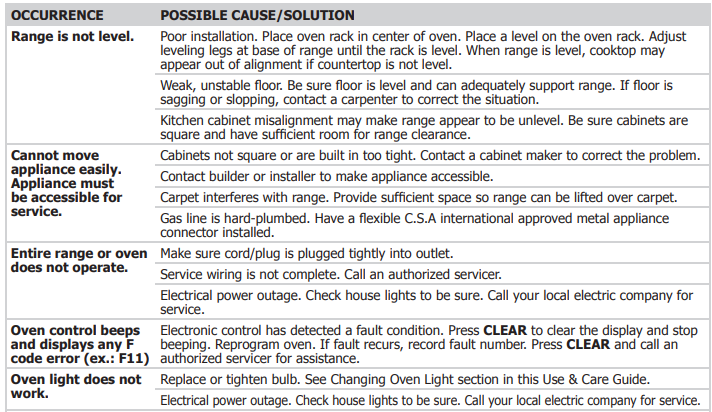
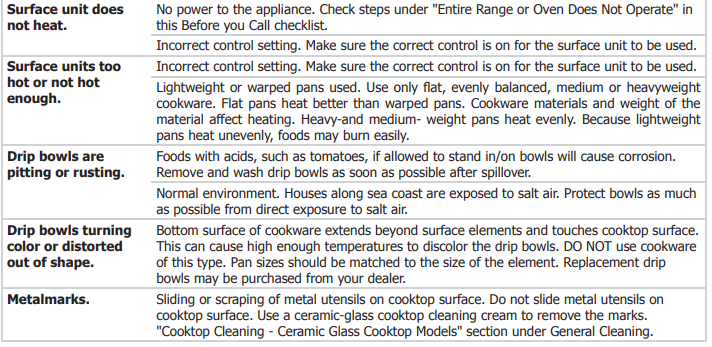
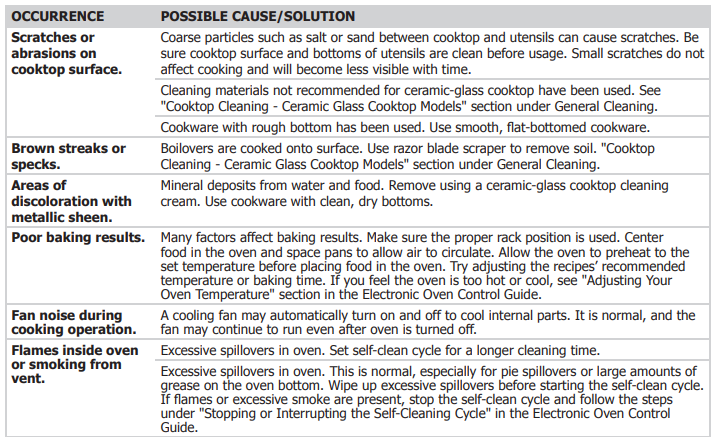

MAJOR APPLIANCE WARRANTY
Your appliance is covered by a one-year limited warranty. For one year from your original date of purchase, Electrolux will pay all costs for repairing or replacing any parts of this appliance that prove to be defective in materials or workmanship when such appliance is installed, used, and maintained by the provided instructions.
Exclusions This warranty does not cover the following:
- Products with original serial numbers that have been removed, altered, or cannot be readily determined.
- Product that has been transferred from its original owner to another party or removed outside the USA or Canada.
- Rust on the interior or exterior of the unit.
- Products purchased “as-is” are not covered by this warranty.
- Food loss due to any refrigerator or freezer failures.
- Products used in a commercial setting.
- Service calls that do not involve malfunction or defects in materials or workmanship, or for appliances not in ordinary household use or used other than by the provided instructions.
- Service calls to correct the installation of your appliance or to instruct you how to use your appliance.
- Expenses for making the appliance accessible for servicing, such as removal of trim, cupboards, shelves, etc., which are not a part of the appliance when it is shipped from the factory.
- Service calls to repair or replace appliance light bulbs, air filters, water filters, other consumables, knobs, handles, or other cosmetic parts.
- Surcharges including, but not limited to, any after-hour, weekend, or holiday service calls, tolls, ferry trip charges, or mileage expenses for service calls to remote areas, including the state of Alaska.
- Damages to the finish of appliance or home incurred during installation, including but not limited to floors, cabinets, walls, etc.
- Damages caused by: services performed by unauthorized service companies; use of parts other than genuine Electrolux parts or parts obtained from persons other than authorized service companies; or external causes such as abuse, misuse, inadequate power supply, accidents, fires, or acts of God.
DISCLAIMER OF IMPLIES WARRANTIES; LIMITATION OF REMEDIES
The customer’s sole and exclusive remedy under this limited warranty shall be product repair or replacement as provided herein. Claims based on implied warranties, including warranties of merchantability or fitness for a particular purpose, are limited to one year or the shortest period allowed by law, but not less than one year. Electrolux shall not be liable for consequential or incidental damages such as property damage and incidental expenses resulting from any breach of this written limited warranty or any implied warranty. Some states and provinces do not allow the exclusion or limitation of incidental or consequential damages, or limitations on the duration of implied warranties, so these limitations or exclusions may not apply to you. This written warranty gives you specific legal rights. You may also have other rights that vary from state to state.
FAQS About Frigidaire CFES3025 Built-In Range Use and Care
How Do I Install My Frigidaire CFES3025 Built-In Range?
Refer to the installation section of the manual for step-by-step instructions, including safety precautions.
What Do I Do If There’s an Issue with the Oven Temperature?
Check the manual for guidance on calibrating or adjusting the oven temperature if necessary.
How Do I Clean the Oven and Cooktop Surfaces?
Look for information on recommended cleaning methods and materials to maintain the appearance of your range.
Troubleshooting Oven Performance Issues
Find troubleshooting tips for common issues with the oven, such as uneven baking or problems with the convection feature.
Understanding and Using Different Oven Modes
Learn about the various cooking modes and settings available on your CFES3025 range.
How Do I Set the Clock and Timer?
Refer to the manual for instructions on setting and adjusting the clock and timer features.
What Type of Cookware Is Suitable for My Range?
Check for information on recommended cookware types and any restrictions on material.
How to Use the Self-Cleaning Feature
If your range has a self-cleaning feature, the manual should provide detailed instructions and safety precautions.
Maintaining and Replacing Oven Light Bulbs
Find information on how to replace oven light bulbs and any maintenance tasks related to lighting.
Warranty Information
Understand the warranty coverage, what it includes, and how to contact customer support if you encounter any issues.
For more manuals by Frigidaire ManualsDock
Click to visit more manuals of Frigidaire’s ice makers:

